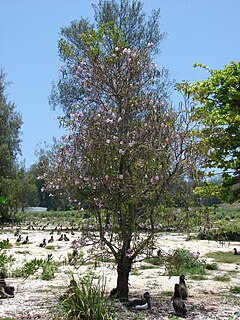
The striated heron also known as mangrove heron, little heron or green-backed heron, is a small heron, about 44 cm tall. Striated herons are mostly non-migratory and noted for some interesting behavioral traits. Their breeding habitat is small wetlands in the Old World tropics from west Africa to Japan and Australia, and in South America and the Caribbean. Vagrants have been recorded on Oceanic islands, such as Chuuk and Yap in the Federated States of Micronesia, the Marianas and Palau; the bird recorded on Yap on February 25, 1991, was from a continental Asian rather than from a Melanesian population, while the origin of the bird seen on Palau on May 3, 2005 was not clear.

The broad-striped Malagasy mongoose or broad-striped vontsira is a species of Galidiinae, a subfamily of mongoose-like euplerids native to Madagascar. The species contains two known subspecies: Galidictis fasciata fasciata and Galidictis fasciata striata.

The striated starling is a species of starling in the family Sturnidae. It is endemic to New Caledonia.

Eugenia haematocarpa is a rare species of plant in the family Myrtaceae. It is endemic to Puerto Rico. It is classified as an endangered species by the U.S. Fish and Wildlife Service and there has been a plan for its recovery in place for some years. Its common names include uvillo and Luquillo Mountain stopper.
Rapanea striata is a species of broadleaf evergreen plant in the family Primulaceae. It is endemic to India.
Tabebuia anafensis is a species of plant in the family Bignoniaceae. It is endemic to Cuba. It is threatened by habitat loss.
Tabebuia arimaoensis is a species of plant in the family Bignoniaceae. It is endemic to Cuba.
Tabebuia bibracteolata is a species of plant in the family Bignoniaceae. It is endemic to Cuba.
Tabebuia dubia is a species of plant in the family Bignoniaceae. It is endemic to Cuba. It is threatened by habitat loss.
Tabebuia elongata is a species of plant in the family Bignoniaceae. It is endemic to Cuba.
Tabebuia furfuracea is a species of plant in the family Bignoniaceae. It is endemic to Cuba. It is threatened by habitat loss.

Tabebuia hypoleuca is a species of plant in the family Bignoniaceae. It is endemic to Cuba.
Tabebuia jackiana is a species of plant in the family Bignoniaceae. It is endemic to Cuba.
Tabebuia lapacho is a species of plant in the family Bignoniaceae. It is found in Argentina and Bolivia. It is threatened by habitat loss.
Tabebuia oligolepis is a species of plant in the family Bignoniaceae. It is endemic to Cuba. It is threatened by habitat loss.
Tabebuia platyantha is a species of plant in the Bignoniaceae family. It is endemic to Jamaica.
Tabebuia polymorpha is a species of plant in the family Bignoniaceae. It is endemic to Cuba. It is threatened by habitat loss.
Tabebuia shaferi is a species of plant in the family Bignoniaceae. It is endemic to Cuba. It is threatened by habitat loss.

Poecilotheria striata, or the Mysore ornamental tarantula, is a large arboreal tarantula of the family Theraphosidae. It is endemic to India.

Tabebuia heterophylla is a species of tree native to the Caribbean, and is also cultivated. It is also known as pink manjack, pink trumpet tree, white cedar, and whitewood.







